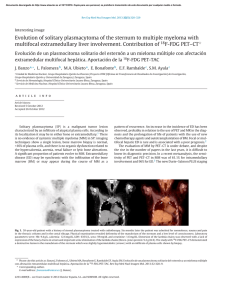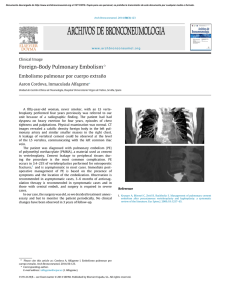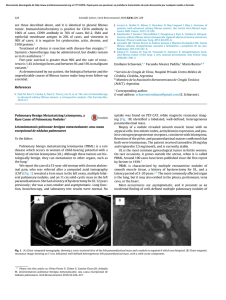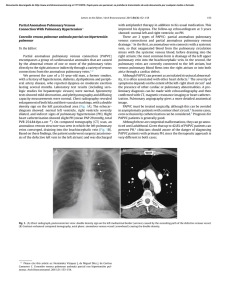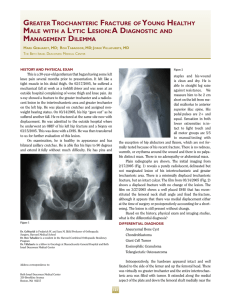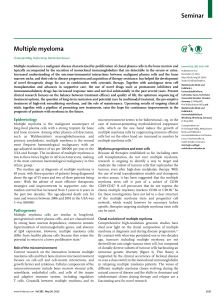Three Cases of Primary Pulmonary Plasmacytoma
Anuncio
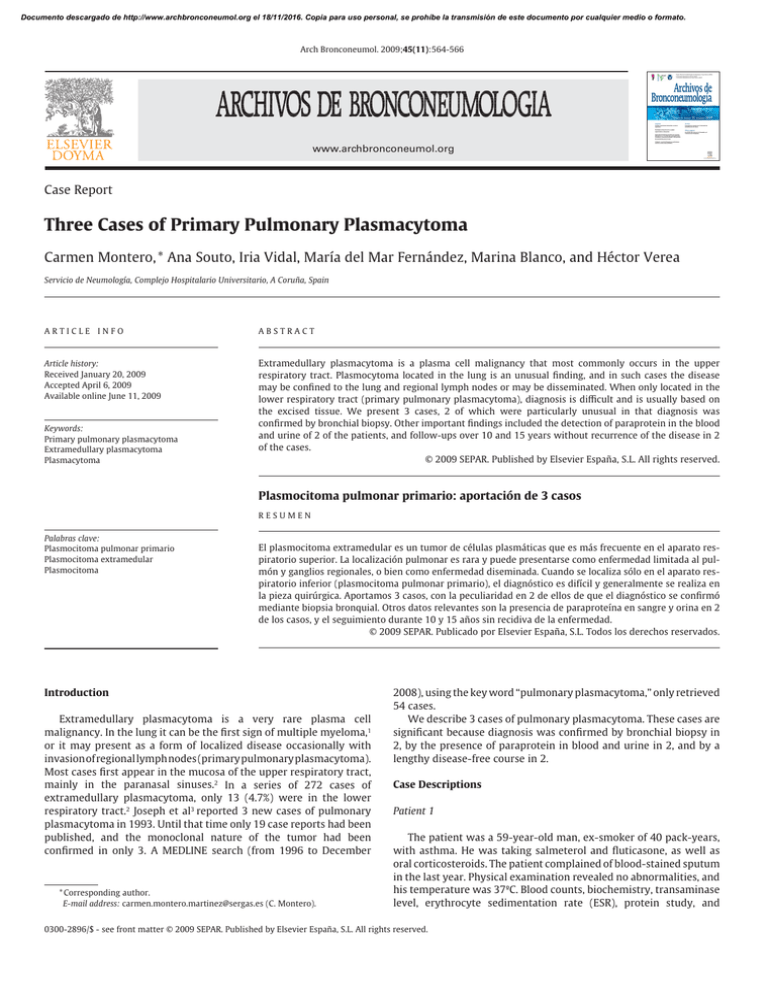
Documento descargado de http://www.archbronconeumol.org el 18/11/2016. Copia para uso personal, se prohíbe la transmisión de este documento por cualquier medio o formato. Arch Bronconeumol. 2009;45(11):564-566 Órgano Oficial de la Sociedad Española de Neumología y Cirugía Torácica (SEPAR), la Asociación Latinoamericana del Tórax (ALAT) y la Asociación Iberoamericana de Cirugía Torácica (AIACT) Archivos de Bronconeumología ISSN: 0300-2896 Volumen 45, Número 11, Noviembre 2009 Originales Revisión Cuidados respiratorios intermedios: un año de experiencia Prescripción de ejercicio en el tratamiento de deshabituación del tabaco Resultados asistenciales de una unidad especializada en tabaquismo Impacto del tratamiento preventivo con agonistas adrenérgicos �2 de acción larga y glucocorticoides inhalados en la morbimortalidad de 1.543 episodios de exacerbación grave de asma Artículo especial Año SEPAR 2007. Año para la Prevención y el Tratamiento del Tabaquismo Incidencia y características de las agudizaciones asmáticas en Barcelona (ASMAB II) www.archbronconeumol.org www.archbronconeumol.org Case Report Three Cases of Primary Pulmonary Plasmacytoma Carmen Montero, * Ana Souto, Iria Vidal, María del Mar Fernández, Marina Blanco, and Héctor Verea Servicio de Neumología, Complejo Hospitalario Universitario, A Coruña, Spain ARTICLE INFO ABSTRACT Article history: Received January 20, 2009 Accepted April 6, 2009 Available online June 11, 2009 Extramedullary plasmacytoma is a plasma cell malignancy that most commonly occurs in the upper respiratory tract. Plasmocytoma located in the lung is an unusual finding, and in such cases the disease may be confined to the lung and regional lymph nodes or may be disseminated. When only located in the lower respiratory tract (primary pulmonary plasmacytoma), diagnosis is difficult and is usually based on the excised tissue. We present 3 cases, 2 of which were particularly unusual in that diagnosis was confirmed by bronchial biopsy. Other important findings included the detection of paraprotein in the blood and urine of 2 of the patients, and follow-ups over 10 and 15 years without recurrence of the disease in 2 of the cases. © 2009 SEPAR. Published by Elsevier España, S.L. All rights reserved. Keywords: Primary pulmonary plasmacytoma Extramedullary plasmacytoma Plasmacytoma Plasmocitoma pulmonar primario: aportación de 3 casos RESUMEN Palabras clave: Plasmocitoma pulmonar primario Plasmocitoma extramedular Plasmocitoma El plasmocitoma extramedular es un tumor de células plasmáticas que es más frecuente en el aparato respiratorio superior. La localización pulmonar es rara y puede presentarse como enfermedad limitada al pulmón y ganglios regionales, o bien como enfermedad diseminada. Cuando se localiza sólo en el aparato respiratorio inferior (plasmocitoma pulmonar primario), el diagnóstico es difícil y generalmente se realiza en la pieza quirúrgica. Aportamos 3 casos, con la peculiaridad en 2 de ellos de que el diagnóstico se confirmó mediante biopsia bronquial. Otros datos relevantes son la presencia de paraproteína en sangre y orina en 2 de los casos, y el seguimiento durante 10 y 15 años sin recidiva de la enfermedad. © 2009 SEPAR. Publicado por Elsevier España, S.L. Todos los derechos reservados. Introduction Extramedullary plasmacytoma is a very rare plasma cell malignancy. In the lung it can be the first sign of multiple myeloma,1 or it may present as a form of localized disease occasionally with invasion of regional lymph nodes (primary pulmonary plasmacytoma). Most cases first appear in the mucosa of the upper respiratory tract, mainly in the paranasal sinuses.2 In a series of 272 cases of extramedullary plasmacytoma, only 13 (4.7%) were in the lower respiratory tract.2 Joseph et al3 reported 3 new cases of pulmonary plasmacytoma in 1993. Until that time only 19 case reports had been published, and the monoclonal nature of the tumor had been confirmed in only 3. A MEDLINE search (from 1996 to December * Corresponding author. E-mail address: [email protected] (C. Montero). 2008), using the key word “pulmonary plasmacytoma,” only retrieved 54 cases. We describe 3 cases of pulmonary plasmacytoma. These cases are significant because diagnosis was confirmed by bronchial biopsy in 2, by the presence of paraprotein in blood and urine in 2, and by a lengthy disease-free course in 2. Case Descriptions Patient 1 The patient was a 59-year-old man, ex-smoker of 40 pack-years, with asthma. He was taking salmeterol and fluticasone, as well as oral corticosteroids. The patient complained of blood-stained sputum in the last year. Physical examination revealed no abnormalities, and his temperature was 37ºC. Blood counts, biochemistry, transaminase level, erythrocyte sedimentation rate (ESR), protein study, and 0300-2896/$ - see front matter © 2009 SEPAR. Published by Elsevier España, S.L. All rights reserved. Documento descargado de http://www.archbronconeumol.org el 18/11/2016. Copia para uso personal, se prohíbe la transmisión de este documento por cualquier medio o formato. C. Montero et al / Arch Bronconeumol. 2009;45(11):564-566 565 immunoglobulin (Ig) levels were normal. A Bence Jones protein test in urine was negative after 24 hours. The chest radiograph showed a nodule in the left hilum and the computed tomography scan (CT) revealed a tumor in the left main bronchus and enlarged subcarinal lymph nodes. Bronchoscopy confirmed a polypoid tumor that almost completely occluded the left main bronchus. Bronchial aspirates showed no malignant cells and the bronchial biopsy confirmed an IgA kappa-type plasma cell malignancy. The bone scan and bone marrow biopsy ruled out multiple myeloma. The mediastinal lymph nodes and tumor were removed and an end-to-end anastomosis was created. The surgical margins were clear and 3 subcarinal lymph nodes were infiltrated. Treatment was completed with radiotherapy. The patient is currently asymptomatic and has remained disease-free during a follow-up of 10 years. Patient 2 The patient was a 64-year-old man, ex-smoker of 80 pack-years who reported fever and weight loss starting 3 months earlier. His temperature was 38ºC and blood pressure was 140/80 mm Hg. Lung and heart sounds were normal, and there was no evidence of lymph nodes disease or enlargement. The hemogram showed a red cell fraction of 34%; hemoglobin concentration of 10 g/dL; and normal corpuscular volume. The ESR was 120 mm/h. The biochemistry, ions, and transaminase level were normal, and blood, urine, and sputum cultures were negative. A chest radiograph and CT scan revealed a mass in the right upper lobe and no abdominal abnormalities. Bronchoscopy was performed 3 times. The appearance was normal. Bronchial aspirates and transbronchial biopsy samples contained abundant plasma cells but no evidence of bronchogenic carcinoma. Stain and cultures for bacteria, fungi, and mycobacteria were negative. The results of a transthoracic biopsy and eventually a surgical biopsy were inconclusive. The patient continued to have fever and gradually developed anemia with hemoglobin levels falling to 7 mg/dL. A bone marrow biopsy was normal. Two months later, a protein study revealed a total protein concentration of 7 g/dL. The titers of IgG, IgA, and IgM were 2330 mg/dL (normal, 51-1560 mg/ dL), 391 mg/dL (normal, 82-453 mg/dL), and 232 mg/dL (normal, 46–304 mg/dL), respectively. A monoclonal band of IgG kappa was found on electrophoresis. A Bence Jones protein test found a level of 36.1 mg/dL (504 mg/24 h) in urine. Immunohistochemical techniques confirmed the IgG kappa plasmacytoma. The bone scan and a second bone marrow biopsy were normal. Radiotherapy was given until a dose of 6000 rad was reached. Hemoglobin levels gradually recovered and protein levels became normal in blood and urine. A disease-free period of 15 years followed. Patient 3 A 56-year-old man, an ex-smoker of 60 pack-years, reported cough producing blood-stained sputum in the last 6 months. He reported no fever, weakness or loss of appetite or weight. Physical examination revealed no abnormalities and blood, biochemical, ion, and transaminase analyses were normal. The ESR was 60 mm/h. The protein level was 7 g/dL and a monoclonal band identified IgA kappa. The titers of IgG, IgA, and IgM were 1140 mg/dL (normal, 751– 1560 mg/dL), 1360 mg/dl (82–453 mg/dL), and 69 mg/dL (46– 304 mg/dL), respectively. The chest radiograph showed a mass and reduced right upper lobe volume (Figure 1). The CT scan confirmed the presence of a right upper lobe bronchial tumor measuring 5 × 3.5 cm across, and malignant mediastinal lymph node disease with no sign of abdominal metastasis. Bronchoscopy found a mass causing stenosis of the right upper lobe bronchus (Figure 2). Bronchial biopsy confirmed an IgA kappa-type plasma cell malignancy. No abnormalities were observed Figure 1. Large mass in the right hilum, responsible for loss of right lung volume. Figure 2. Stenosis in the bronchus of the right upper lobe caused by tumor infiltration of the mucosa. in the bone scan and bone marrow biopsy. Radiotherapeutic treatment of the thoracic mass was started. Clinical and radiologic response was good, and at the end of treatment the blood protein level was normal, the urine for proteinuria was negative, and there was no bone marrow biopsy evidence of myeloma. Adjuvant chemotherapy was started. The patient developed fever and signs of septic shock during the third cycle and died. A second bone marrow biopsy before that third cycle had commenced had been normal. Discussion Extramedullary plasmacytoma is a monoclonal proliferation of plasma cells in soft tissues or an organ. The relationship between multiple myeloma, solitary plasmacytoma of bone, and extramedullary plasmacytoma is not well understood. For some authors these 3 entities represent different aspects of the same disease spectrum. Others regard solitary plasmacytoma of bone as a rare manifestation of multiple myeloma. Extramedullary plasmacytoma should, however, be regarded differently and the diagnosis restricted to tumors that occur outside the bone marrow, may infiltrate nearby lymph nodes or cause distant metastasis.2 The most common location for plasmacytoma is the submucosa of the upper airways.2 This predisposition may be explained by the abundance of plasma cells in the submucosa of the upper respiratory tract and the continuous exposure to antigenic stimuli. In the lower Documento descargado de http://www.archbronconeumol.org el 18/11/2016. Copia para uso personal, se prohíbe la transmisión de este documento por cualquier medio o formato. 566 C. Montero et al / Arch Bronconeumol. 2009;45(11):564-566 airway, plasmacytoma settles in the tracheobronchial tree, structures of the hilum3 or, exceptionally, in the lung parenchyma.7 Extramedullary plasmacytoma in upper airways is more common in men (male-to-female ratio ranging from 3:1 to 5:1), but no predilection of the pulmonary form for either sex has been found. The most usual age of onset is 50 to 60 years, and clinical signs reflect the location of the tumor. When the mass is in the bronchial tree, as in 2 of our patients, cough and blood-tinged sputum are common. Tumors in the trachea cause a sense of suffocation.8 The most frequent radiologic finding is a pulmonary nodule or mass near the hilum, similar to the type of lesion seen in 2 of our patients. Lobar consolidation and bilateral diffuse infiltrates have also been described, but this manifestation is very rare.7 Little is known about endoscopic findings, but as occurred in our third patient, infiltration of the mucosa (Figure 2) has been observed, along with polypoid tumors (similar to our first patient), all lesions which are comparable to those seen in bronchogenic carcinoma.9 Primary pulmonary plasmacytoma evolves differently from multiple myeloma, and prolonged survival rates have been described. However, they are so rare that nothing is known about prognosis. Some cases have presented monoclonal gammopathy in serum, generally IgG,10 in relation to tumor size and may indicate an unfavorable course. A case has been described in which the first sign was renal failure secondary to hematologic monoclonal gammopathy, which became normal after resection.5 Our 2 patients with plasma paraprotein also had a larger tumor. A treatment for primary pulmonary plasmacytoma has not been fully established. Surgical resection can be considered curative if it is complete.11,12 Some surgically treated patients have also been given radiotherapy. Others have received radiotherapy and chemotherapy. There appears to be no difference in survival, though it is difficult to evaluate as follow-up information is scant. In the largest series in the literature, 66% survived 2 years and 40% survived 5 years. Two patients survived 20 years.4 We have described 3 new cases of primary pulmonary plasmacytoma and would like to emphasize that the clinical and radiologic signs and the course of disease were distinct from multiple myeloma. We therefore consider it important to report new cases with long-term follow-up in order to confirm whether primary pulmonary plasmacytoma should be considered a different entity from multiple myeloma and solitary plasmacytoma of bone. Based on these and other cases in the medical literature, we are inclined to think that primary pulmonary plasmacytoma behaves similarly to other extramedullary plasmacytomas that tend to occur in the lung, infiltrate regional lymph nodes, or metastasize to sites outside the chest, but without spread to bone marrow.13,14 If this interpretation is confirmed, disease management would mainly consist of local treatment to prevent their local invasion and spread; for tumors measuring over 5 cm or those that are highly undifferentiated, whether to apply adjuvant chemotherapy or not would have to be assessed.15 References 1. Kintzer S, Rosenow E, Kyle R. Thoracic and pulmonary abnormalities in multiple myeloma. A review of 958 cases. Arch Intern Med. 1978;138:727-30. 2. Wiltshaw E. The natural history of extramedullary plasmacytoma and its relation to solitary myeloma of bone and myelomatosis. Medicine (Baltimore). 1976;55: 217-38. 3. Joseph G, Pandit M, Korfhage L. Primary pulmonary plasmacytoma. Cancer. 1993; 71:721-4. 4. Koss MN, Hochoholzer L, Moran CA. Pulmonary plasmacytomas: a clinicopathologic and immunohistochemical study of five cases. Ann Diagn Pathol. 1998;2:1-11. 5. Wise J, Schaefer R, Read R. Primary pulmonary plasmacytoma. Chest. 2001;120: 1405-7. 6. Terzi A, Furlan G, Zannoni M, Adovasio A, Gorla A. Endobronchial extramedullary plasmacytoma. Report of one case. Lung Cancer. 1996;16:95-100. 7. Horiuchi T, Hirokawa M, Oyama Y, Kitabayashi A, Satoh K, Shindoh T, et al. Diffuse pulmonary infiltrates as a roentgenographic manifestation of primary pulmonary plasmacytoma. Am J Med. 1998;105:72-4. 8. Kairalla R, Carvalho C, Parada A, Alves V, Saldiva P. Solitary plasmacytoma of the trachea treated by loop resection and laser therapy. Thorax. 1988;43:1011-2. 9. Blanco I, Burgués C, Puzo C. Propuesta de terminología de las lesiones endobronquiales en pacientes con sospecha de neoplasia bronquial. Arch Bronconeumol. 2007;43:36-9. 10. Chang CC, Chang YL, Lee LN, Lee YC. Primary pulmonary plasmacytoma with immunoglobulin G/lambda light chain monoclonal gammopathy. J Thorac Cardiovasc Surg. 2006;132:984-5. 11. Wang J, Pandha HS, Treleaven J, Powles R. Metastatic extramedullary plasmacytoma of the lung. Leuk Lymphoma. 1999;35:423-5. 12. Hayes-lattin B, Blanke CD, Deloughery T. Pulmonary and intracerebral plasmacytomas in a patient without multiple myeloma: a case report. Am J Hematology. 2003;73:131-4. 13. Marisavljevis D, Markovic O, Cemerkic-Martinovic V, Ponomarev D. Plasmacytoma of lung: an indolent disease resistant to conventional myeloma treatment. Med Oncol. 2005;22:207-10. 14. Shaikh G, Sehgal R, Mehrishi A, Karnik A. Primary pulmonary plasmacytoma. J Clin Oncol. 2008;26:3089-91. 15. Soutar R, Lucraft H, Jacson G. Guidelines on the diagnosis and management of solitary plasmacytoma of bone and solitary extramedullary plasmacytoma. Br J Haematol. 2004;124:717-26.
